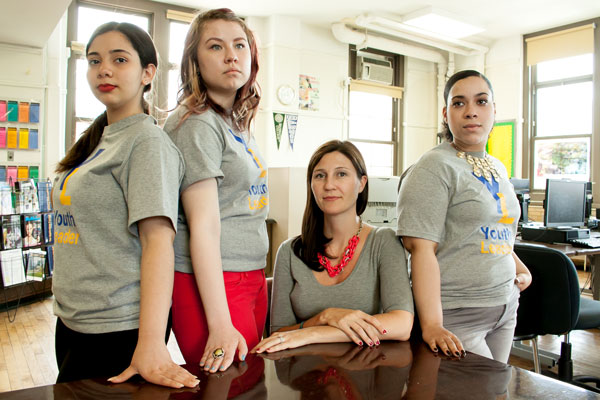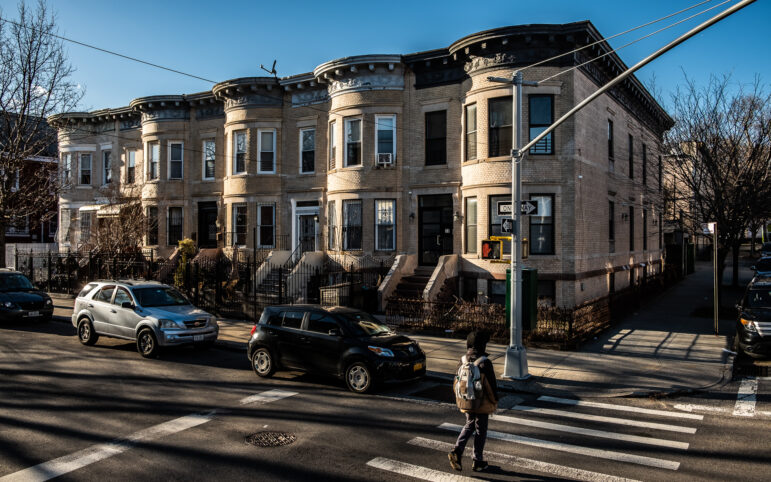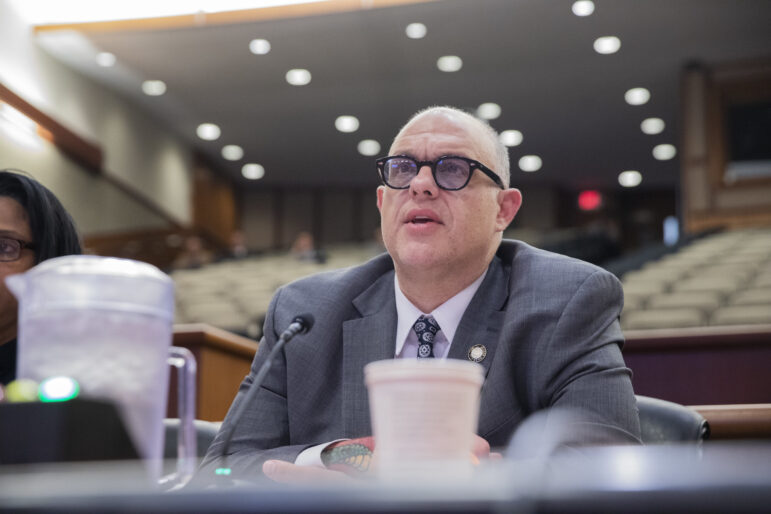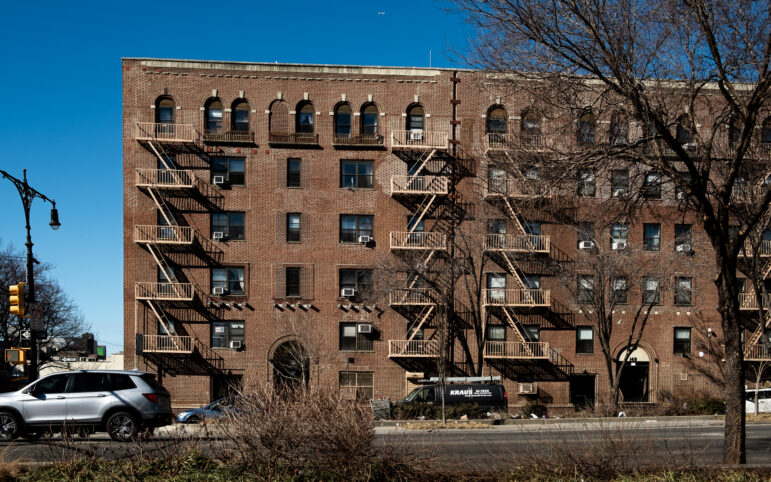
Photo by: Adi Talwar
at the High School of Fashion Industries in Manhattan, college readiness is not only the focus of Kate McKeon, seated, the college counselor, but also Youth Leaders (standing, from left to right) Alondra Rivera, Gabriella Ramalho and Maria Santana.
Four young women, heads bobbing up and down, are leaning over their desks in Jeff Newman’s 11th grade social studies class at Fashion Industries High School in Manhattan in late March. But instead of peering at historical documents, trying to figure out what were the precipitating causes of the Civil War, they are perusing statistics on three colleges and comparing them according to a list of criteria ranging from total enrollment to percentage of applicants admitted, diversity, tuition, top majors and percentage of students who graduate in six years.
This is all part of Fashion Industries’ APPS program, an initiative that has nothing to do with fashion or technology but everything to do with exposing first-generation college applicants to what college is all about and how to survive when they get there. The acronym stands for Advocating and Preparing for Post-Secondary Readiness. At a school—like the majority of public schools in New York City—where most students would be the first in their family to go to college, the principal and the teachers at Fashion Industries felt they had to do more than simply get kids in to college. “We looked at our numbers,” said principal Daryl Blank, “”We had a 90 percent college admissions rate—better than a lot of schools—but we had a big gap in the numbers who were still enrolled in school six months later. We needed to have a school-wide initiative.”
Fashion Industries is one of many high schools grappling with how to prepare all of their students not only to get accepted into a college but how to navigate the post-secondary world and graduate. The Bloomberg administration established a “college readiness” metric on its school Progress Reports in 2011 after noticing that, despite rising graduation rates, over 70 percent of New York City high-school students who went on to CUNY had to take remedial classes before they could begin their regular college classes.
But college readiness is about more than pure academics. The complex college search process to find a college that is the best fit, the quest for financial aid and preparation for the independence and lack of rigid structure that characterizes college life are a challenge for all students, but especially those whose parents didn’t attend college, are immigrants or have few resources. Low-income kids, who are often the first in the family to go to college, may not even have known anyone who has graduated from college.
Because so many of New York City’s students are first-generation college students, high schools have to shoulder the responsibility of raising questions that might be part of normal dinner conversation in middle-class homes. Why go to college? What are the options for college? Which college is for you? How do you decide? What kind of financial aid can you get? And what do you do when you get there?
A lack of guidance
At a time when everyone from President Obama on down has talked about the importance of post-secondary education, in New York City college guidance varies tremendously from school to school. Stuyvesant High School has four college counselors; Brooklyn Tech has two college counselors and another person assigned specifically to help students on scholarship and financial aid. Bronx High School of Science has 12, expecting all of its guidance counselors to do college counseling.
This is not the case at other schools, and particularly at the newer small schools. While small schools were touted during the Bloomberg years as answers to the problems plaguing old-fashioned large high schools, the reduction in size has led to bare-bones staffing. Because a school’s budget is based on the numbers of students it serves, some small schools have one guidance counselor in charge of everything: programming, academic counseling, the special education population—and, perhaps, college guidance. Across the board in New York City, over 50 percent of students have a student-to-guidance counselor ratio of over 250 to 1, according to a 2012 study from former Comptroller John Liu’s office.
At the same time, there is increasing need for college guidance and support. While nationwide college-graduation rates have nearly tripled from 1971 to 2013, there is a strikingly different picture when you break out the numbers by family income,. In 2009, while 82.4 percent of 24-year-olds from families with the top income had four-year degrees, only 8.3 percent of 24-year-olds from the bottom family income tier did. In a competitive New York City economy focused on finance, technology, law and the media, it is even more obvious here than in the rest of the country how necessary a college degree is to survive.
A September 2013 report from the Center for New York City Affairs intensely examined college-readiness and made a number of recommendations, including that the city’s Department of Education (DOE) provide each school with a direct budget line for a college counselor, similar to the one for parent coordinators that Bloomberg established. It also called for the DOE to help train staff to find effective partners among the more than 250 community-based non-profits that are now providing college support and advisement services to students around the city. They range from Goddard Riverside Community Center’s Options Center on the upper west side of Manhattan, which has been providing college advisement services since 1986, to newer organizations that have recently tried to fill in the gaps in neighborhoods where schools have dropped the ball. In addition, said the report, the DOE should consider providing a formal curriculum for grades 6 through 12 on career and college planning and guidance “and work to create a ‘college culture’ in the public schools.”
An official with the DOE’s Office of Post-Secondary Readiness disagreed with the idea of focusing on putting a college counselor in every school. “We know lots of schools which have a broader way of approaching it,” she said. “We want to be more strategic. We want to ratchet up the capacity of a multiplicity of adults in schools to do college counseling well.” She said the approaches vary from school to school. “We want to work collaboratively with school staffs to find the right approach.”
Since 2011, her office has offered training sessions though Goddard Riverside’s Options Institute that to date have reached over 1,000 high schools staffers. The DOE official (who declined to be named) said 67 percent of high schools have had at least one person go through the six-day training. And she said the office is involved in helping schools select the best non-profits to fit their particular needs.
Former Comptroller Liu’s report called for adding 1,600 new guidance counselors to the 1,300 already working in the schools in order to lower student-to counselor ratios to 100-1.The report also suggested separating guidance responsibilities, like social and emotional counseling, programming and special education support and college advisement so students can get the specialized help they need. The additional hires would only cost $176 million, or less than 1 percent of current spending, according to the report. (The DOE’s former chief academic officer, Shael Polakow-Suransky, disputed the numbers in a forum sponsored by the Center for New York City Public Affairs in June 2013 said it would probably cost $600-700 million.)
The Liu report underlines how important adding those college advisors will be: “To ensure that students are equipped with the fundamental academic and developmental tools to succeed and thrive in a higher-education environment, schools must adopt a ‘college-going culture’. . . through an integrated program of counseling and mentoring services.”
A cultural goal
Some high schools—like Fashion Industries and others—have been way ahead in thinking about how to create a college-going culture in their schools. In addition to having a college advisor, they have brought in non-profits to provide an array of other resources. Other high schools have not done so well.
Jermani Faulk, 17, was sitting in the storefront office of the College Success program of the Cypress Hills Development Corporation, under the elevated train along Fulton Street in East New York, in early April. “I thought about college, but I was not on track…I didn’t know what college to go to, how to apply, anything like that,” Jermani said, leaning forward on a folding chair, his red Chicago Bulls hat hanging on his knee. “It was kinda my fault. I always knew I wanted to go to college, but I didn’t know the steps.”
As self-critical as the open and serious 17-year-old is, neither of whose parents attended college, he probably should not shoulder all the blame. Jermani’s school, the High School of Civil Rights, one of the four small schools in the old Thomas Jefferson High School building in East New York, has no college point-person. It’s only because of the counselor from the College Success program who works with a caseload of 25 to 35 of the school’s seniors that Jermani is weighing acceptances from 11 to 12 colleges. The principal did not respond to several phone calls and emails to discuss what the high school does provide in terms of college advisement.
Cypress Hills Local Development Corporation is one of those 250 community-based organizations that have picked up the slack in many low-income communities, often filling in where schools have failed to provide their students much help in the college decision process. Their Fulton Street storefront office pulls in others who are, for whatever reason, only beginning to consider college.
Fashion Industries has put into place many of the proposals mentioned in Center for New York City Affairs report. Last year, the faculty of the school sat down in grade-level teams to figure out how to make their students more “college-ready.”
“What are the skills that these guys need? What are we hearing from colleges that they lack?” were the questions at hand, explained Newman. The staff put together a month-by-month plan across all grades on how nitty-gritty writing and research skills were to be taught, culminating with written projects in each of several content areas and formal presentations in each grade.
Oftentimes, even students who were high-achieving in high school quickly discover that they may not be as well prepared as they thought when they get to college. When Shevanna Cole, 20, who graduated in 2012 from Cypress Hills Collegiate Preparatory School, a small high school in the old Franklin K. Lane campus in Brooklyn, went to the Higher Education Opportunity Program summer program at Skidmore College, her lack of preparation hit her like a ton of bricks. “People really questioned my writing,” she remembers. “I had gotten a lot of A’s in high school and now I was getting C’s and D’s. It made me question myself.” And that was even before the fall when she joined regular classes, “Before, everyone looked like me,” she says. “Now it was a different playing field.”
While high schools ratcheting up the rigor of their academics is key, it is only one part of what college prep is. That is why Fashion Industries established the APPS classes for students on every grade level, one of which the principal himself teaches, where students are introduced to the idea of college starting in 9th grade. And Fashion Industries not only has Kate McKeon, a dedicated college advisor, as well as six other guidance counselors who’ve been trained to do college advisement, but it also has eight “Youth Leaders”—juniors and seniors who serve as guides, goads, big brothers and big sisters for their fellow students..
“School is such a big decision for all of us,” says Maria Santana, the daughter of Dominican immigrants, is only the second person in her family to go to college after her older brother and is the student body president as well as a Youth Leader. “Students have jobs, take care of younger brothers and sisters. . . .Filling out applications correctly or on time is not their biggest priority.” Youth Leaders have caseloads of 60 students each and work with them individually on their applications and their financial aid forms and also run workshops and presentations for freshmen and sophomores to get them to start thinking about the college process.
The eight Youth Leaders, along with over 60 counterparts in 20 other schools or college-based organizations around the city, are part of Youth Leadership for College Access. It is a program of College Access: Research and Action (CARA), a non-profit which is housed at the CUNY Graduate Center that was started three years ago by Lori Chajet and Janice Bloom, two former high-school teachers who direct the program. “We started to think about college success—how we can help students not only get into college but also flower there,” says Chajet. “Neither of us wanted to just write about it. We wanted to figure out practices to deal with it.” Having worked with high-school students who were the first in their family to go to college—or to even consider college—both understood that college support and guidance is a vital part of what high schools had to offer students.
The Youth Leader model is an important part of what they do. “Because they are going through it themselves, they can be the most helpful to other students because they know where they are coming from,” says Chajet. CARA provides the youth leaders with over 16 days of training during the summer and over the year so they become experts in everything from CUNY, SUNY and private college options to educational opportunity programs to financial aid. “What we find is as they learn to counsel other kids at their school about college, they’re taking it out to their sisters, brothers, their housing projects as well,” she says.
At Central Park East Secondary School in East Harlem also has a team of Youth Leaders. They’re joined in the college push by, a dedicated college counselor, Jessica Pemstein, provided through the College Bound Initiative (CBI)
The College Bound Initiative is a college guidance program of the Young Women’s Leadership Network, a non-profit that runs five all-girls public schools in New York City. It was started in 2001 to help students through the college process. From the Network’s own five schools, it quickly spread to other co-ed public high schools. CBI is now in 21 schools, serving 1,300 to 1,400 seniors. Pemstein, CBI’s college counselor at Central Park East, teaches college prep workshops in junior and senior classes, brings in college representatives and organizes college trips.
At Central Park East, like Fashion Industries, discussion of college starts in 9th grade, not junior or senior year. Both use CARA’s 350-page College Inquiry curriculum, which attempts to move discussions about college into classrooms. “Every adult who has a point of contact with our kids is important in terms of discussing college,” says principal Bennett Lieberman.
Stemming ‘the summer flood’
It’s estimated that there are 22 steps, including the crucial filing of financial aid documents, that have to be made before students can actually show up on campus. According to a longitudinal study of 500 low-income graduates from 50 innovative urban high schools all over the country, over a third of the students changed their plans about going to college at all or switched colleges during the summer after they have been admitted. The phenomenon is called “the summer flood.”
A sudden family catastrophe from a death to illness to eviction, the kinds of things that high-school students from poor families often face, can cause admitted students to change their minds. Sometimes it can be the pressure from the family to get a job rather than going away to school.
Sotonye Douglas’ job is to staunch the summer flood. Currently a student at SUNY/Albany, she’s working back at her high school, Kurt Hahn Expeditionary Learning School in East Flatbush, as part of College Bridge, another program of CARA that hires and trains 35 college students to work in their former high schools to supplement the college counselors and to run interference with some of the issues that come up once the students are admitted to college.
Douglas, 20, is a college coach extraordinaire. She graduated in 2011 as part of the school’s first graduating class and is majoring in human biology with a minor in art history. On her spring break, she was already following up with her caseload of 50 seniors at her old school. Once she finishes at Albany for the year, she’ll be back at Kurt Hahn working with college applicants again.
In March, she sat down with seniors in front of a computer going over a wide Excel sheet, checking off what they had done so far, and still have to do, but more importantly checking in with them on how they—and their families—are feeling about the move to college.
One young woman, Brigette, said she had changed her mind about going to York College, where she initially wanted to study social work, to instead enroll in an eight-month program at a for-profit beauty school, costing $17,000. “They say I can apply for scholarships,” she said. Douglas was quiet, warm—and thoughtful.
The young woman hadn’t had a chance to talk to her mother about her change in plans. Her mother was in the hospital. “I’ll talk to Ms. Alexander [the college counselor] and see what she suggests.”
Another young woman, Shaina, had been accepted into SUNY Albany but she and her family were asked to come up with $13,000 in loans. Her mother said she can’t afford it. Albany is Shaina’s dream school. “I’ve cried about it already,” she said. They strategized about how to discuss it with her mother.
Sometimes, of course, the counseling doesn’t end up pointing a student toward a traditional college degree. After discussing her case, Brigitte decided to stick with beauty school.
Helping parents play their role
In many schools in low-income neighborhoods, the parents often take a low profile in the college process. Only 29 percent of New York City public school parents have a college degree of any kind, according to the American Community Survey. Some work two or three jobs, don’t speak English, are undocumented, feel the financial aid questions are intrusive or because they never had to apply to college, find the process overwhelming and beyond them.
At Kurt Hahn, the school made a big effort this year to make parents a part of the college conversation. At the end of March, they held a College Café, a four-hour program of workshops on the college application process, finding the right school and talking about college. About 45 families came—some parents bringing their kids, some students bringing their parents. There were even raffles and door prizes.
Some of the questions parents raised in one of the sessions included, “How can I pay for college as a single parent?” “My son wants to go away—how can I keep tabs on him?” “What’s the right college for my daughter?” “How can I get my son to care about college? All he cares about is sports.”
Matt Brown, the principal, was happy with the outcome. Roughly 100 people had come, and heard his big take-home message—that there’s life after high school for which a lot of planning is needed. As Brown put it to the gathered parents and college hopefuls, “It’s not just about their four years here.”
For Phil Weinberg, the newly appointed Deputy Chancellor for Teaching and Learning under Chancellor Carmen Fariña, the discussion about how to prepare students for higher education is a familiar one. He served as principal of the High School of Telecommunications, a well-regarded high school of 1,300 students in Brooklyn, for 13 years. Telecommunications has two college advisors (who also teach as well), and a college office on the first floor, “which is one of the first things you see when you come in,” he said. Students, starting in 9th grade, are taken on college trips “and we start talking about what happens after high school from the beginning,” he said.
When it comes to the citywide high-school system, Weinberg wouldn’t commit in a phone interview this week to creating a budget line for college advisors, but he said “it will be one of the things we want to look at.”
While it is clear that the DOE is still in the process of formulating policies about college counseling and advisement, Weinberg is straightforward: “Part of our jobs is to be transparent to our students from the beginning in all our 1,800 schools that college and career readiness is what we’re about…things don’t end after high school,” he said. “The end goal is providing students with options and the ability to make thoughtful choices on their own.”
Read about one star student’s
struggles in college.








